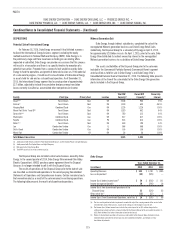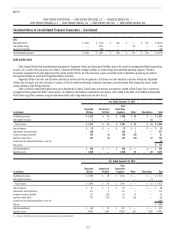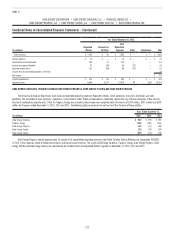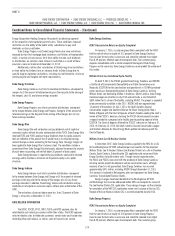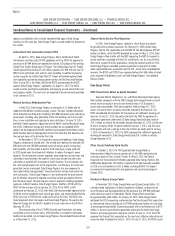Duke Energy 2015 Annual Report Download - page 144
Download and view the complete annual report
Please find page 144 of the 2015 Duke Energy annual report below. You can navigate through the pages in the report by either clicking on the pages listed below, or by using the keyword search tool below to find specific information within the annual report.
124
PART II
DUKE ENERGY CORPORATION • DUKE ENERGY CAROLINAS, LLC • PROGRESS ENERGY, INC. •
DUKE ENERGY PROGRESS, LLC • DUKE ENERGY FLORIDA, LLC • DUKE ENERGY OHIO, INC. • DUKE ENERGY INDIANA, INC.
Combined Notes to Consolidated Financial Statements – (Continued)
Energy Corporation Holding Company (the parent) by obtaining approval
of the respective state regulatory commissions. These conditions imposed
restrictions on the ability of the public utility subsidiaries to pay cash
dividends as discussed below.
Duke Energy Progress and Duke Energy Florida also have restrictions
imposed by their first mortgage bond indentures and Articles of Incorporation
which, in certain circumstances, limit their ability to make cash dividends
or distributions on common stock. Amounts restricted as a result of these
provisions were not material at December 31, 2015.
Additionally, certain other subsidiaries of Duke Energy have restrictions
on their ability to dividend, loan or advance funds to Duke Energy due to
specific legal or regulatory restrictions, including, but not limited to, minimum
working capital and tangible net worth requirements.
Duke Energy Carolinas
Duke Energy Carolinas must limit cumulative distributions subsequent to
mergers to (i) the amount of retained earnings on the day prior to the closing of
the mergers, plus (ii) any future earnings recorded.
Duke Energy Progress
Duke Energy Progress must limit cumulative distributions subsequent
to the merger between Duke Energy and Progress Energy to (i) the amount of
retained earnings on the day prior to the closing of the merger, plus (ii) any
future earnings recorded.
Duke Energy Ohio
Duke Energy Ohio will not declare and pay dividends out of capital or
unearned surplus without the prior authorization of the PUCO. Duke Energy Ohio
received FERC and PUCO approval to pay dividends from its equity accounts
that are reflective of the amount that it would have in its retained earnings
account had push-down accounting for the Cinergy Corp. (Cinergy) merger not
been applied to Duke Energy Ohio’s balance sheet. The conditions include a
commitment from Duke Energy Ohio that equity, adjusted to remove the impacts
of push-down accounting, will not fall below 30 percent of total capital.
Duke Energy Kentucky is required to pay dividends solely out of retained
earnings and to maintain a minimum of 35 percent equity in its capital
structure.
Duke Energy Indiana
Duke Energy Indiana must limit cumulative distributions subsequent
to the merger between Duke Energy and Cinergy to (i) the amount of retained
earnings on the day prior to the closing of the merger, plus (ii) any future
earnings recorded. In addition, Duke Energy Indiana will not declare and pay
dividends out of capital or unearned surplus without prior authorization of the
IURC.
The restrictions discussed above were less than 25 percent of Duke
Energy’s net assets at December 31, 2015.
RATE RELATED INFORMATION
The NCUC, PSCSC, FPSC, IURC, PUCO and KPSC approve rates for
retail electric and natural gas services within their states. The FERC approves
rates for electric sales to wholesale customers served under cost-based rates
(excluding Ohio and Indiana), as well as sales of transmission service.
Duke Energy Carolinas
FERC Transmission Return on Equity Complaint
On January 7, 2016, a customer group filed a complaint with the FERC
that the rate of return on equity of 10.2 percent in Duke Energy Carolinas’
transmission formula rates is excessive and should be reduced to no higher
than 8.49 percent, effective upon the complaint date. The customer group
requests consolidation with a similar complaint filed against Duke Energy
Progress on the same day. Duke Energy Carolinas cannot predict the outcome of
this matter.
William States Lee Combined Cycle Facility
On April 9, 2014, the PSCSC granted Duke Energy Carolinas and NCEMC
a Certificate of Environmental Compatibility and Public Convenience and
Necessity (CECPCN) for the construction and operation of a 750 MW combined-
cycle natural gas-fired generating plant at Duke Energy Carolinas’ existing
William States Lee Generating Station in Anderson, South Carolina. Duke Energy
Carolinas began construction in July 2015 and estimates a cost to build of
$600 million for its share of the facility, including AFUDC. The project is expected
to be commercially available in late 2017. NCEMC will own approximately
13 percent of the project. On July 3, 2014, the South Carolina Coastal
Conservation League and Southern Alliance for Clean Energy jointly filed a
Notice of Appeal with the Court of Appeals of South Carolina seeking the court’s
review of the PSCSC’s decision, claiming the PSCSC did not properly consider
a request related to a proposed solar facility prior to granting approval of the
CECPCN. The Court of Appeals affirmed the PSCSC’s decision on February 10,
2016. On February 23, 2016, the South Carolina Coastal Conservation League
and Southern Alliance for Clean Energy filed a petition for rehearing with the
Court of Appeals.
William States Lee III Nuclear Station
In December 2007, Duke Energy Carolinas applied to the NRC for a COL
for two Westinghouse AP1000 (advanced passive) reactors for the proposed
William States Lee III Nuclear Station (Lee Nuclear Station) at a site in Cherokee
County, South Carolina. Submitting the COL application did not commit Duke
Energy Carolinas to build nuclear units. Through several separate orders,
the NCUC and PSCSC concurred with the prudency of Duke Energy Carolinas
incurring certain project development and pre-construction costs, although
recovery of costs is not guaranteed. Duke Energy Carolinas has incurred
approximately $471 million, including AFUDC through December 31, 2015.
This amount is included in Net property, plant and equipment on Duke Energy
Carolinas’ Consolidated Balance Sheets.
Design changes have been identified in the Westinghouse AP1000
certified design that must be addressed before NRC can complete its review of
the Lee Nuclear Station COL application. These design changes set the schedule
for completion of the NRC COL application review and issuance of the Lee COL.
Receipt of the Lee Nuclear Station COL is currently expected by late 2016.
Duke Energy Progress
FERC Transmission Return on Equity Complaint
On January 7, 2016, a customer group filed a complaint with the FERC
that the rate of return on equity of 10.8 percent in Duke Energy Progress’
transmission formula rates is excessive and should be reduced to no higher
than 8.49 percent, effective upon the complaint date. The customer group



